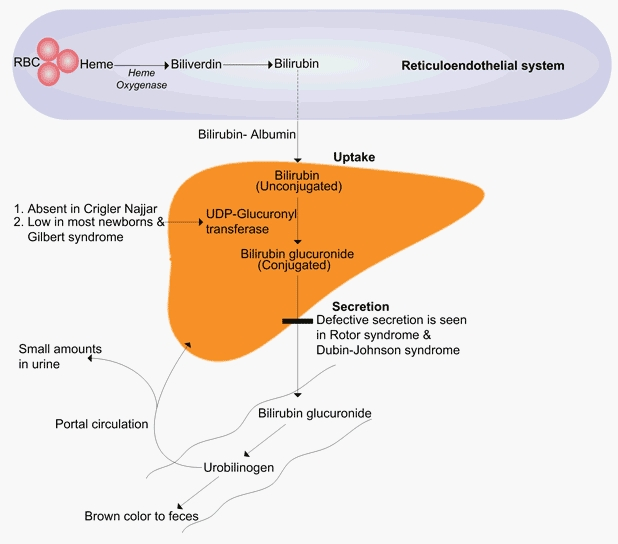Metabolic Fate of Bilirubin and MCQs for GPAT, NEET UPSC, CSIR NET Exam
Bilirubin is less soluble than biliverdin in aqueous medium. Bilirubin is an effective anti-oxidant. The metabolism and excretion of bilirubin occurs in liver and intestine it is divided in 4 processes:
- Uptake of bilirubin by liver cell: bilirubin is transported to the liver by binding to plasma protein albumin. In liver it is removed from albumin and is then it binds to the liver intracellular protein lingadin.
- Conjugation of bilirubin in smooth ER in liver: hepatocytes then convert sparingly soluble bilirubin into more soluble form. This conversion is done by the conjugation of two molecules of glucuronate and yields the product bilirubin diglucuronide.
- Secretion of conjugated bilirubin into bile: most of the bilirubin secreted in the bile is in the form of bilirubin diglucuronide. This is rate limiting step of bilirubin metabolism. Un-conjugated bilirubin is not secreted into bile.
- Excretion of bilirubin: after the secretion into bile, the conjugated bilirubin passes into intestinal lumen. bilirubin diglucuronide is hydrolyzed in the intestine by bacterial enzymes to form free bilirubin.
The bilirubin is then reduced to colorless urobilinogen which further takes two alternative routes
- A part of it is transported to the kidney where it is oxidized to urobilin and then is excreted in urine. The yellow color of urine is due to urobilin.
- A part is returned to the liver and then re-excreted through liver to the intestine.
A major part of urobilinogen remains in intestinal lumen and is reduced to stercobilinogen in the feces. Brown color of stool is due to stercobilin.
 This image is taken only for educational purpose from th.bing.com
This image is taken only for educational purpose from th.bing.com
Multiple Choice Questions (MCQs)
1. Out of bilirubin and biliverdin, which is more soluble in aqueous form?
A. Biliverdin
B. Bilirubin
C. Both
D. None
2. Where do excretion and metabolism of bilirubin occurs?
A. Liver
B. Spleen
C. Intestine
D. Both A and C
3. Metabolism and excretion process of bilirubin is divided in how many process or stages?
A. 2
B. 3
C. 4
D. 5
4. Which cells functions for uptake of bilirubin?
A. Parietal cells
B. Chief cells
C. Parenchymal cells
D. None of the above
5. Where do conjugation of bilirubin in liver takes place?
A. Nucleus
B. Endoplasmic reticulum
C. Cytoplasm
D. Mitochondria
6. Bilirubin is bound to which plasma protein for its transport to peripheral tissues?
A. Globulin
B. Albumin
C. Fibrinogen
D. All of the above
7. In the liver, bilirubin binds to which intracellular protein?
A. Ligandin
B. Apolipoprotein
C. Both
D. None
8. Match the following enzyme and its product-
A. Beta-glucuronidase 1. Bilirubin
B. Heme oxygenase 2. Biliverdin
C. Biliverdin reductase 3. Urobilinogen
9. Out of bilirubin or biliverdin, which is an effective antioxidant?
A. Bilirubin
B. Biliverdin
C. Both
D. None
10. Which step for the metabolism of bilirubin is termed as rate limiting step?
A. Uptake of bilirubin
B. Conjugation of bilirubin
C. Excretion of bilirubin
D. None of the above
11. What is the color of urobilinogen?
A. Orange
B. Red
C. Brown
D. Colorless
12. Which of the following statement is NOT true?
A. Brown color of stool is due to bilirubin
B. Catabolism of heme is don through reticuloendothelial system
C. Secretion of bilirubin into bile is rate limiting step of bilirubin metabolism
D. Bilirubin is an effective anti-oxidant
13. What is the reason for yellow color of urine?
A. Presence of bile
B. Presence of bilirubin
C. Presence of urobilin
D. Reason is not constant
14. What is the reason for the brown color of stool?
A. Presence of bile
B. Presence of stercobilin
C. Presence of urobilin
D. Reason is not constant
15. Which of the following is the intermediate of bilirubin metabolism and excretion?
A. Bilirubin-diglucuronide
B. Urobilinogen
C. Stercobilinogen
D. All of the above
ANSWERS-
1. Biliverdin
2. Both A and C
3. 4
4. Parenchymal cells
5. Endoplasmic reticulum
6. Albumin
7. Ligandin
8. A – 3 B – 2 C – 1
9. Bilirubin
10. None of the above
11. Colorless
12. Brown color of stool is due to bilirubin
13. Presence of urobilin
14. Presence of stercobilin
15. All of the above
Participate in Online FREE GPAT TEST: CLICK HERE
Participate in Online FREE Pharmacist TEST: CLICK HERE
Participate in Online FREE Drug Inspector TEST: CLICK HERE
Participate in CSIR NET JRF Mock Test
REFERENCE:- 1. Pankaja Naik- Biochemistry; 4th edition; page no:- 317-318
2. U Satyanarayana, U Chakrapani- Biochemistry; 4th edition; page no